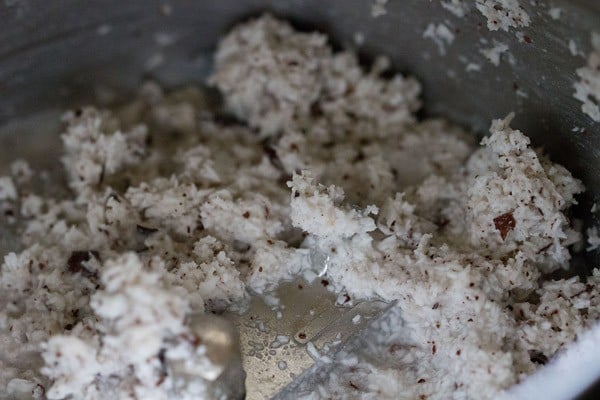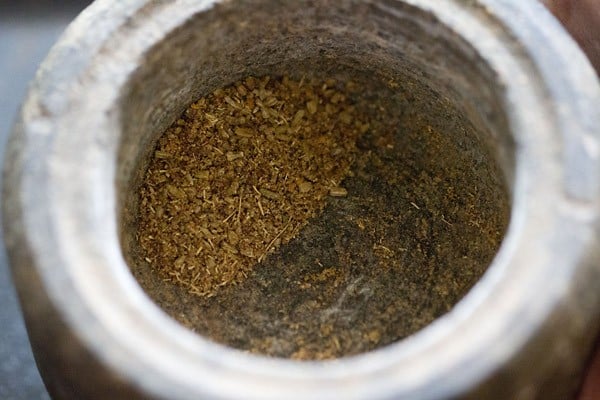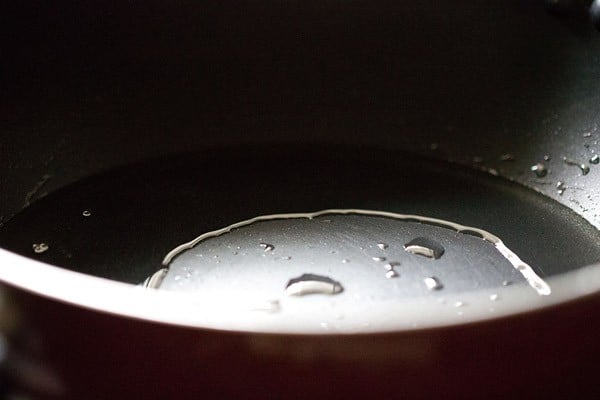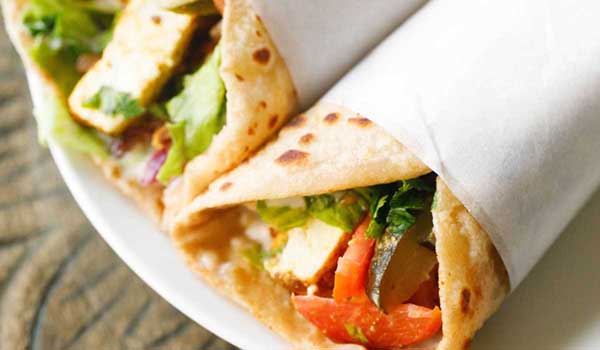Kadala Curry (also known as Kadala Kari) is a flavorful and aromatic dish made with black chickpeas, onions, herbs, coconut, and a variety of warming spices. This beloved curry is traditionally enjoyed with Puttu or Appam for breakfast in Kerala cuisine. Follow my step-by-step guide, complete with photos, to master this comforting gluten-free and vegan curry!
About Kadala Curry Recipe
Kadala is the Malayalam term for “chickpeas,” which are also referred to as kala chana, desi chana, or whole Bengal gram. Kari translates to “curry,” as you might have guessed.
This hearty recipe features a rich base of whole spices, onions, herbs, ground spices, and coconut paste, into which cooked black chickpeas are added and simmered.
Chickpeas are an excellent source of vegetarian protein, fiber, and essential nutrients, making this curry a healthy option.
This traditional Kerala recipe is naturally vegan and gluten-free, making it a wonderful meal to share with friends and family.
Kadala Kari paired with Puttu (steamed rice and coconut cakes) is one of my favorite breakfast combinations, reflecting its popularity in Kerala.
While this dish makes for a delicious breakfast, Kadala Curry can also be served with rice, chapatis, or pooris for lunch or dinner.
This recipe requires a special Kerala garam masala, which is a warming spice blend. Since this blend may not be readily available in stores, I have provided a small quantity tailored for this recipe.
As with many Indian dishes, there are numerous variations of Kadala Curry, ranging from gravy to semi-dry versions. Some variations include coconut milk, while others use fresh or roasted coconut, and some do not use coconut at all. This particular recipe is loosely adapted from the ‘Essential Kerala Cookbook’ by Vijayan Kannampilly.
This spicy Kadala Curry is versatile and can be served with puttu, appams, idiyappam, steamed rice, chapati, or poori, depending on your preference and what you have on hand.
How to Make Kadala Curry
Prepare Chickpeas
1. Rinse and soak 1 cup of black chickpeas in 2 cups of water for 8 to 9 hours (or overnight).
Note: White chickpeas can also be used in place of black chickpeas.
Tip: In a hurry? Boil the water before pouring it over the chickpeas. Let them soak in hot water for an hour before draining and cooking.
For a quick option, use drained and rinsed canned white chickpeas and skip to step 5.

2. Place the soaked black chickpeas in a 3-liter stovetop pressure cooker with ½ teaspoon of salt.

3. Add 2.5 cups of fresh water.

4. Stir to combine, then pressure cook the chickpeas for about 9 to 10 whistles, until they are tender. Reserve the stock (aquafaba) and keep it aside.
You can also cook the chickpeas in a pot on the stovetop or in an Instant Pot, adding water as needed.

Make Coconut Paste
5. While the chickpeas are cooking, add ½ cup of tightly packed grated coconut to a grinder or blender jar.

6. Add ¼ to ⅓ cup of water and blend until smooth. (Add more water if necessary.) Set the ground coconut paste aside.
Ensure the coconut is blended finely.
Make Kerala-style Garam Masala
7. In a small pan, dry roast the following spices until fragrant:
- ½ teaspoon fennel seeds
- 2 to 3 strands of mace
- 1-inch cinnamon stick
- 3 whole cloves
- 3 pinches of grated nutmeg or nutmeg powder
This is a light roasting to awaken the oils in the spices; avoid over-roasting.
You can use a pre-packaged spice blend if preferred.

8. Using a spice grinder, coffee grinder, or mortar and pestle, grind the spices into a semi-fine or fine powder. Set aside.

Make Onion & Spices Curry Base
9. Heat 2 tablespoons of coconut oil in a pan. While coconut oil adds great flavor, you can substitute it with any neutral oil if desired.

10. Add ½ teaspoon of mustard seeds and let them crackle.

11. Add ⅓ cup of chopped pearl onions or shallots. Stir and sauté for a minute.

12. Add 1 teaspoon of chopped ginger, 1 teaspoon of chopped green chilies, and 10 to 12 curry leaves. Sauté until the shallots turn translucent or light golden.

13. Add 1 teaspoon of red chili powder, 1 teaspoon of coriander powder, ¼ teaspoon of black pepper powder, and the ground Kerala garam masala. If using packaged Kerala garam masala, add 1 teaspoon.
Tip: I use a full teaspoon of red chili powder for spiciness, but you can reduce it to ½ teaspoon for a milder flavor. You may also add 1 finely chopped medium tomato if desired.

14. Stir the spices well over low heat and sauté for a minute.

15. Add the ground coconut paste.

16. Stir and mix thoroughly.

17. Sauté for about 4 to 5 minutes on low heat, stirring often.

Make Kadala Curry
18. Add the cooked black chickpeas (kadala).

19. Stir and mix well.

20. Add 1 to 1.25 cups of liquid—this can be water, chickpea stock (the water used to cook the chickpeas), or a combination of both. Stir to combine.
For a thicker curry, add less water; for a thinner consistency, increase the water slightly, but be cautious not to dilute the flavors.

21. Season with salt and stir again. Start with a small amount of salt; you can always add more later!

22. Allow the curry to come to a boil over medium heat.

23. Simmer until the flavors meld together, and you see oil specks floating on top. For a thicker consistency, mash some of the black chickpeas with the back of a spoon.

24. Serve Kadala Curry hot or warm with puttu, appams, idiyappam, steamed rice, Malabar Parotta, or poori. Optionally, garnish with chopped coriander leaves.
Leftovers can be stored in an airtight container in the refrigerator for about a day. When reheating, add a splash of water if the curry has thickened too much, and reheat in a pan or small pot.

Expert Tips
- Alternative Legumes: You can substitute black chickpeas with dried white chickpeas, black-eyed beans, or kidney beans. Avoid using the soaking water; instead, use fresh water for cooking. Canned white chickpeas can also be used.
- Coconut Type: This recipe works well with frozen coconut. If fresh or frozen coconut is unavailable, unsweetened desiccated coconut can be used.
- Add Tang: To introduce a tangy flavor, consider adding 1 small to medium-sized chopped tomato.
- Oil Options: Coconut oil is traditionally used for its flavor and aroma. If you prefer, use a neutral oil instead.
- Curry Consistency: Adjust the consistency of the curry by adding more or less water according to your preference, but avoid making it too thin to preserve the flavors.
- Scaling: This recipe can easily be adjusted to make smaller or larger batches as needed.
- Cooking black chickpeas in a pot: To cook in a pot, combine soaked chickpeas, 2.5 to 3 cups of water, and salt. Cover and bring to a boil, then cook on medium to high heat until tender.
FAQs
Yes! Kadala curry can be stored in the refrigerator for up to a day. Reheat gently on the stove, adding water as needed if it thickens.
While black chickpeas are traditional, you can substitute with white chickpeas, red kidney beans, or black-eyed beans if necessary.
Mace and nutmeg come from the same tree, so you can substitute with a pinch of freshly grated nutmeg.
You can use coconut milk instead of fresh ground coconut. After adding the cooked chickpeas to the sautéed mix, include about ¼ to ⅓ cup of water. After mixing, lower the heat and add 1 cup of thick coconut milk, adjusting the consistency as needed. Avoid boiling to prevent splitting.





